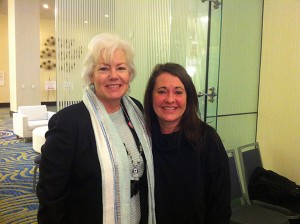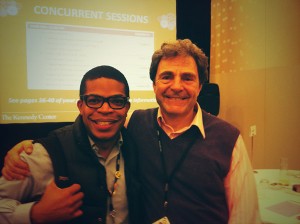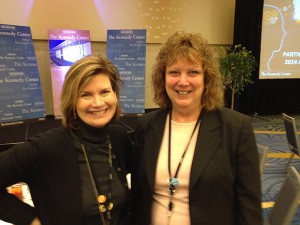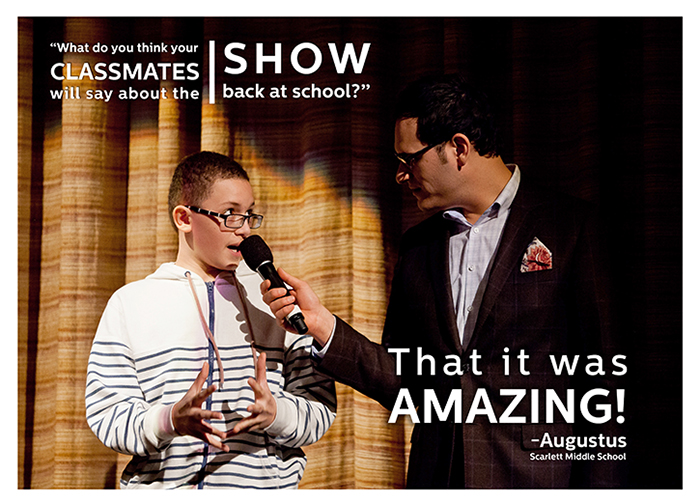Kennedy Center Annual Meeting Reflection and Report
The Kennedy Center’s Partners in Education Annual Meeting is a provocative, rewarding, and beyond worthwhile professional development experience…EVERY YEAR! I attend as part of the “Michigan 1997” partnership team, which also includes Robin Bailey (Ann Arbor Public Schools), Jennifer Scott-Burton (Washtenaw Intermediate School District), and Jim Leija (UMS). We get great work done as a team and spend individual time thinking slow, reflecting, and connecting with colleagues from around the country.
Some highlights:
Snow!
Equally as significant as the convening’s great content delivery was the precipitation delivery that shutdown DC, documented through many tweets.
In DC for a conference now. In my hotel people are trading pillows and remote controls for food. #dclockdown #jk
— Omari Rush (@RushOmari) February 13, 2014
#theycallthisasnowstorm? #kced http://t.co/zhLg0RHsUf — Jim Leija (@jimleija) February 13, 2014
Snow sculpture on the National Mall pic.twitter.com/f7oXfk4Ynb — Dave_Steele (@Dave_Steele) February 14, 2014
Sessions
MI 1997 was highly engaged in leadership roles at this year’s conference…maybe more so than any other team:
- The whole MI 1997 was a lead presenter in two sessions: “Making Partnerships Work” and “Preparing to Bring Students to Performances and Exhibits
- Jim gave a presentation on the new UMS TalkOut program at the “Bright Ideas” session (check out the slides)
- Robin is on the National Advisory Committee and had various facilitation duties
- Omari was on the Nominating Committee for the Advisory Committee
Other presenters led wonderful sessions too:
- Daniel Pink motivated us with his talk about embracing unconstrained work time…”Fedex Time”
- Ryan Hourigan spoke about the power of making the arts accessible and inclusive to students in special education programs (he’s a U-M PhD alum too!)
- Eric Jansen presented compelling and fully digestible brain research highlighting the connections between arts learning and personal development
- ALSO, Barbara Shepherd, Garry Golden, and Eric Booth extended their streaks of presenting bold ideas that invite paradigm shifts in thinking.
Outcomes
We get LOTS done too…and this this year we actually REDESIGNED our UMS K-12 Program!!! More soon…
Three Take Aways
- Commit to a Gaudy Goal: something that’s big, ridiculous, and creates stretch
- Make Learning Links Explicit: Sometimes the links are so obvious that we forget to do this.
- Integrate Advocacy: To be effective, impact assessment and sharing needs to be embedded rather than added on
Educational partners at work #kced @RushOmari #umslobby pic.twitter.com/KdCOo2Af3s
— Jim Leija (@jimleija) February 14, 2014
Inspiration
Our team finds bits of inspiration throughout the Annual Meeting, and some of that comes from hearing what’s inspiring others around the country.
Photos: From L to R: Barbara Shepherd with Jennifer Scott-Burton (left) and Omari Rush with Eric Booth (right).
What inspires you, Barbara?
“Connecting people to the people they need to know or connecting people to the resources they need to have. That’s what inspires me to come to work every day.”
— Barbara Shepherd, Kennedy Center’s National Partnerships Director, overseeing programs such as the Partners in Education Program and Any Given Child Initiative
What’s inspiring Eric Booth right now??
“El Sistema! Never before has he encountered an idea that has spread around the world with so many different manifestations, but that all have the same core idea of intense arts engagement that produces significant and meaningful social benefits, and each county working within El Sistema has unique social benefits that they are looking to realize. He’s really excited about this moment in time!”
— Eric Booth (who is described as “the father of the teaching artist profession” and “one of the 50 most important US arts leaders.”)
Photo: Robin Bailey (right) and Kathy Dewsbury-White (left)
What inspires you, Kathy?
“My great colleagues…the good ideas around the US…yeah, that’s what inspires me!”
— Kathy Dewsbury-White, Arts-Related and Integrated Professional Learning Coordinator for the Ingham Independent School District, and a member of the MI 2007 partnership team.
…and Jim captured video of his inspiration probe:
Now, back in Ann Arbor, our task is to use our refreshed minds to spur the positive change and development we envisioned at the Annual Meeting…it’s definitely possible…and already happening.
Educator Conversations: Jazz at Lincoln Center Orchestra with Wynton Marsalis
Editor’s note: This post is a part of a series of conversations between educators in the K-12 community. Educators will offer suggestions and answer questions about integrating UMS School Day Performances or the arts into classroom curriculum, as well as share advice on organizing a field trip to UMS. To volunteer to be a Teacher Lobby Moderator e-mail umsyouth@umich.edu. Or, check out other Educator Conversations.
This week’s questions:
- What does Jazz music have in common with the music of Mozart and Haydn?
- How does Jazz music reflect the values of African-American culture from which it came?
- How do you find yourself improvising in your life?
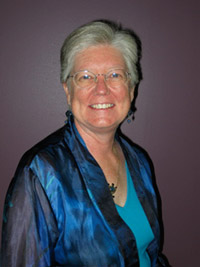 This week’s moderator: Linda Jones. Linda has taught music, math and media in the Ypsilanti Schools from 1999 to 2012. She is currently director of the Ann Arbor Civic Chorus. She has taught jazz history, composition, improvisation and performance as well as acting and creative movement at the elementary level and collaborated with bassist Paul Keller, drummer Sean Dobbins, and pianist Ellen Rowe. She has training as an Orff Music Educator and currently serves as Treasurer to the Greater Detroit Orff Schulwerk Association. She has presented workshops on Jazz improvisation and Composition through Garage Band.
This week’s moderator: Linda Jones. Linda has taught music, math and media in the Ypsilanti Schools from 1999 to 2012. She is currently director of the Ann Arbor Civic Chorus. She has taught jazz history, composition, improvisation and performance as well as acting and creative movement at the elementary level and collaborated with bassist Paul Keller, drummer Sean Dobbins, and pianist Ellen Rowe. She has training as an Orff Music Educator and currently serves as Treasurer to the Greater Detroit Orff Schulwerk Association. She has presented workshops on Jazz improvisation and Composition through Garage Band.
Q: What does Jazz music have in common with the music of Mozart and Haydn?
They both use western harmonic progressions, they both use the same instruments, especially percussion, winds and brass and bass violins. They both have soloists and ensembles. Improvisation is at the heart of Jazz and traditionally there was also improvisation in Baroque performances.
What else can you add to this list?
Q: How does Jazz music reflect the values of African-American culture from which it came?
Everyone has a voice and contributes equally to the ensemble.
Everyone has a chance to shine and show their individual talent.
Collaboration is very important.
Lyrics reflect the reality of life, the loves and struggles, the hope and the suffering.
Talent is mentored and held to a high standard.
Rhythm is the basis of music that cooks, this rhythm flows through all of African-American life.
What else would you include in this list?
Q: How do you find yourself improvising in your life?
I find that teaching is filled with chances to improvise. Lesson plans are only an outline, the craft is in fitting those plans with the needs of the learners present on that day. Any time I am leading a choral rehearsal, I am improvising wildly as I find ways to help the choir improve. Driving also presents plenty of chances to improvise, especially if different routes are possible to get to the destination.
How do you improvise?
Do you have questions or comments for Linda about his approach to this performance or about teaching through performance more broadly? Share your responses or questions in the comments section below.
Educator Conversations: Compagnie Käfig
Editor’s note: This post is a part of a series of conversations between educators in the K-12 community. Educators will offer suggestions and answer questions about integrating UMS School Day Performances or the arts into classroom curriculum, as well as share advice on organizing a field trip to UMS. To volunteer to be a Teacher Lobby Moderator e-mail umsyouth@umich.edu. Or, check out other Educator Conversations.
This week’s questions:
- I want my students to attend an event sponsored by UMS. How can I afford travel expenses?
- I want my all of my students to attend at UMS performance, how can I afford the cost of so many tickets?
- Why dance?
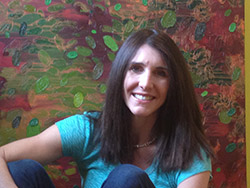 This week’s moderator: Dianne Dudley. Dianne is a Physical Educator for the Ann Arbor Public Schools at Carpenter Elementary. She is the director of the Community High School all-city dance company, Dance Body. She enjoys an active lifestyle with her husband and their four children. She is passionate about creating opportunities for all children to be active. She teaches the free parent/child Dancing Babies creative movement classes for the Ann Arbor Public Library and is a volunteer rec. & ed. coach.
This week’s moderator: Dianne Dudley. Dianne is a Physical Educator for the Ann Arbor Public Schools at Carpenter Elementary. She is the director of the Community High School all-city dance company, Dance Body. She enjoys an active lifestyle with her husband and their four children. She is passionate about creating opportunities for all children to be active. She teaches the free parent/child Dancing Babies creative movement classes for the Ann Arbor Public Library and is a volunteer rec. & ed. coach.
Q: I want my students to attend an event sponsored by UMS or another organization. How can I afford travel expenses?
Community High School was awarded a $350 grant from Michigan Youth Arts (MYA). The all-city dance company will reach out to middle school step teams to attend a University of Michigan Freshman Dance Touring Company performance together during Semester 2. This grant provides an opportunity for more than 60 middle school and high school students to experience a collegiate dance program and performance.
The Michigan Youth Arts’ Arts & Culture Trek Grant program offers grants of up to $500 to Michigan K-12 schools for the transportation cost of an arts and culture field trip. Educators can choose from a list of more than 150 arts and cultural institutions that offer educational programming, exhibits and performances outside the classroom, which enhance the arts and humanities curriculum. The list of available online grants and their due dates for submission can be found on the MYA website.
Q: I want all of my students to be able to attend a UMS performance. How can I afford the cost for so many tickets?
The UMS School Day Performances are offered at a discounted rate for K-12 students. At Community High School, we work with our school PTO to purchase tickets for the entire student body to attend performances together. Our staff and our PTO are committed to providing opportunities to support the Common Core Standards. UMS provides materials for each performance to connect the show to our classroom curriculum. Our teachers use the materials to help facilitate meaningful student engagement before, during, and after the performance.
The UMS Youth Education program includes daytime School Day Performances subsidized for schools, and also Teacher Workshops that energize teaching and learning practices, In-School Visits by performing and teaching artists, and Curriculum Resources to help make direct connections between UMS artists and the classroom.
Q: Why Dance?
I want all of my students to be active so that they can appreciate the physical and mental health benefits of exercise. Dancing is good exercise and a fun way to keep fit. In addition to learning new choreography and dance technique, students work hard throughout the semester to increase their cardiovascular fitness, muscular strength and flexibility. They learn to set realistic goals and learn how to achieve their personal goals. Dance is a great way to raise endorphin and serotonin levels and reduce cortisol levels naturally. I include creative movement and music to all of the lessons I teach at the elementary level. I believe that dancing is a tool that can be used to help bridge our achievement gap. Students bring their own style of dance and experience to the classroom. This can be influenced by their out-of-school opportunities, family and culture. We value, learn, and appreciate dance through every student.
February 14, the Compagnie Käfig modern dance performance will be an excellent field trip opportunity to witness the breath-taking fitness skill-set required to perform with jaw-dropping artistry. This physically demanding dance performance promises a thrilling combination of hip-hop, capoeira dance styles, samba, and acrobatic skills. I will also encourage my students to join dancers from Compagnie Käfig at a free You Can Dance session for an exploration of the company’s movement style on February 13 at the Ann Arbor YMCA.
Do you have questions or comments for Diane about his approach to this performance or about teaching through performance more broadly? Share your responses or questions in the comments section below.
Educator Conversations: One Night in Bamako
Editor’s note: This post is a part of a series of conversations between educators in the K-12 community. Educators will offer suggestions and answer questions about integrating UMS School Day Performances or the arts into classroom curriculum, as well as share advice on organizing a field trip to UMS. To volunteer to be a Teacher Lobby Moderator e-mail umsyouth@umich.edu. Or, check out other Educator Conversations.
This week’s questions:
- Who are these two artists, Bassekou Kouyaté and Ngoni Ba?
- How should I prepare my class for the performance?
- Bamako? What? Where? And who cares?
- Isn’t taking a class on a field trip too much trouble?
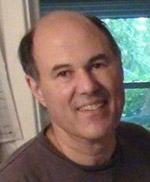 This week’s moderator: Jeff Gaynor. Jeff has been teaching for 35+ years, 20 years at Elementary, and the last 15+ at Clague Middle School, where he teaches Math and Social Studies. He integrates music and art into the curriculum, often prior to field trips, or by bringing guest artists in his classroom. Jeff is on the UMS Teacher Insight Committee has an interest in classical, jazz and world music. He has participated in month-long teacher study trips to Belize, Turkey and South Africa.
This week’s moderator: Jeff Gaynor. Jeff has been teaching for 35+ years, 20 years at Elementary, and the last 15+ at Clague Middle School, where he teaches Math and Social Studies. He integrates music and art into the curriculum, often prior to field trips, or by bringing guest artists in his classroom. Jeff is on the UMS Teacher Insight Committee has an interest in classical, jazz and world music. He has participated in month-long teacher study trips to Belize, Turkey and South Africa.
Q: Who are these two artists: Bassekou Kouyaté and Ngoni Ba?
Ha – this was my first question – and I can save you the same embarrassment. Bassekou Kouyaté is the lead musician. He plays an ancient traditional stringed instrument, like a lute, but he has also modernized it in amazing ways. This instrument is called the ‘ngoni.’ “Ngoni Ba” is the name of the band he leads. Check them out.
Q: How should I prepare my class for the performance?
It’s important that students look forward to the trip with anticipation. The level of academic preparation depends on the grade, subject, and how much time you can spend (pressing issue, I know). At a minimum, I go through the UMS Learning Guide and choose 1 or 2 activities to do with my students. Also very helpful, especially with unusual instruments or genres, is to play audio or video clips in class, and have a discussion to focus attention on how this music is alike or different from other music they have heard.
You can find videos on YouTube, and the Guide has more suggestions. Seeing or listening to the music in your classroom isn’t the real thing, though curiously, the appreciation for the live performance will be increased if students have seen the performer before hand, if on a screen. At a minimum go to the UMS web page and click on “Listen & Learn.”
Of course, the more curriculum connections you make, the more students will take out of the live performance, which leads us to:
Q: Bamako? What? Where? And who cares?
“‘I mean, what is music itself? Music is everywhere, every day. If you’re gonna genuinely do that, you prohibit all sound because music is in language, it’s in everything. It’s totally abhorrent to any musician to be told they can’t play music… It’s a very particular interpretation of the Koran that prohibits all music,’ said Damon Albarn, an Africa Express co-founder.”
Quote from BBC News.
And suddenly, music is more than just music. And Bamako, the capital of Mali, in the horn of Africa, is more than some far away place. And we are teachers – it is our job to show the commonalities and the uniqueness of people in all parts of the globe.
Explore geography – with a map of West Africa, and a map of Mali, point out the the capital of Bamako, the fabled city of Timbuktu (Tombouctou), the Niger River, and the seven countries that border Mali. Find images of these places.
Read folk tales from Mali (or West Africa) as folk tales are universal and also particular. Point out that Bassekou Kouyaté is a griot – a historian and storyteller, through his music.
Most of the northern tier of Africa is heavily Muslim, as is Mali. This is part of their culture and influences the music. Islam is one of the five world religions covered in the Ann Arbor middle school social studies curriculum and may be integrated during the study of Islam or the Middle East or Northern Africa.
The quote that led this section was in response to a crisis in Mali during which Islamic fundamentalists took control of the northern part of the country. France (Mali was a French colony until 1960) then intervened militarily. This is a vital area for research with parallels and ramifications throughout the region.
Q: Isn’t taking a class on a field trip too much trouble?
No! It does take preparation but the benefits far outweigh the effort. And it will be an experience your students will remember for years and link to their classroom learning.
As an elementary teacher, and now middle school social studies teacher, I feel it is eminently important to help students link classroom experiences to the world around them. Reading about a country, or culture, or listening to a CD is one thing; attending a live concert is a visceral experience that brings learning to another level. This music may be different, but music is universal.
UMS keeps the cost of their School Day performances low. As I teach in Ann Arbor, I also choose to have my students travel on the City Bus – a $1.50 round trip, with the benefit that they get more real life experiences. I ask parents to pay the cost (under $10) or what they can, and the School PTSO makes up the difference.
Check out the AATA website for route maps and schedules. You do not need to contact them ahead of time. Do have students go to the back of the bus while you pay the driver for everyone. Do not have each student pay his or her own fare as it takes much too long.
I prepare my class not only for the concert but for taking the bus and walking through city streets: how to wait for and behave on the bus, how to leave space on the sidewalk to allow other pedestrians to pass, how to cross the street – all real life skills that they take seriously. They understand they are now off school property and the expectations are obligatory, not arbitrary. Of course I also prepare them to be good audience members, referring to the UMS Learning Guide for valuable reminders.
In fact the Learning Guide has important and worthwhile resources for pre- and post-concert links, resources and activities. Do take the time to read through it.
Do you have questions or comments for Jeff about his approach to this performance or about teaching through performance more broadly? Share your responses or questions in the comments section below.
UMS TalkOut Project: Hubbard Street Dance Chicago
Editor’s note: This post is a part of a series. View all TalkOut events.
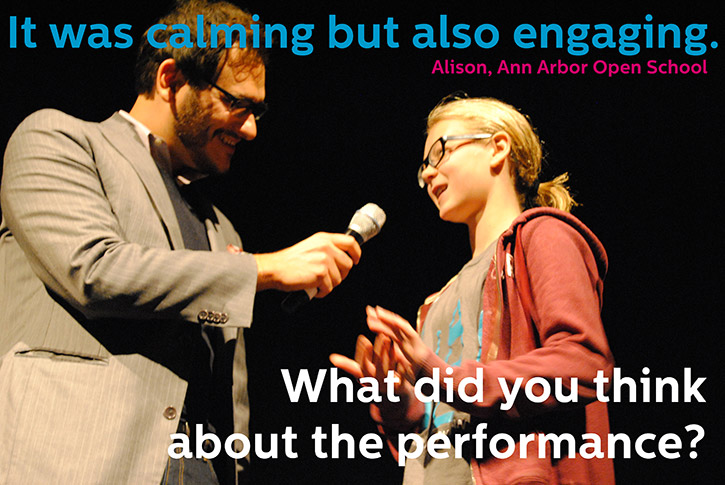
Photo: Alison McCarthy from the Ann Arbor Open School (6th Grade) shares her thoughts.
Our TalkOut project for K-12 students involves speaking and listening (two core K-12 learning competencies) and creating a sharing ripple that allows the experience of a UMS School Day Performance to live on in the minds and hearts of young people and that helps students make connections between the arts on stage and their classroom.
This “TRIMTAB” pilot project was developed with guidance from Eric Booth at the Kennedy Center Partners in Education Program’s February 2013 Annual Meeting by the Michigan 1997 Team: Ann Arbor Public Schools (Robin Bailey), UMS (Jim Leija and Omari Rush), and the Washtenaw Intermediate School District (Jennifer Scott-Burton).
TalkOut encompasses the entire UMS School Day Performance experience. Prior to the start of the show an onstage host provides the entire audience with a framing question. At the end of the performance, two students (selected by UMS and school teachers pre-performance) are invited on stage to share their thoughts and ideas with the entire audience. The feedback is immediately celebrated, captured with photos and audio, and passed on to others for shared reflection.
Here, Lindsay Zinbarg (Saline High School, 12th Grade) participates in TalkOut at the Hubbard Street Dance Chicago performance (interviewed on stage by UMS’s Jim Leija):
Interested in learning more? Download the TalkOut Project Description
UMS K-12 TalkOut Project
Editor’s note: This post is a part of a series. View all TalkOut events.
Our TalkOut project for K-12 students involves speaking and listening (two core K-12 learning competencies) and creating a sharing ripple that allows the experience of a UMS School Day Performance to live on in the minds and hearts of young people and that helps students make connections between the arts on stage and their classroom.
This “TRIMTAB” pilot project was developed with guidance from Eric Booth at the Kennedy Center Partners in Education Program’s February 2013 Annual Meeting by the Michigan 1997 Team: Ann Arbor Public Schools (Robin Bailey), UMS (Jim Leija and Omari Rush), and the Washtenaw Intermediate School District (Jennifer Scott-Burton).
TalkOut encompasses the entire UMS School Day Performance experience. Prior to the start of the show an onstage host provides the entire audience with a framing question. At the end of the performance, two students (selected by UMS and school teachers pre-performance) are invited on stage to share their thoughts and ideas with the entire audience. The feedback is immediately celebrated, captured with photos and audio, and passed on to others for shared reflection.
Here, Kai, a fourth grade student at Ann Arbor’s Pattengill Elementary School, participates in TalkOut at the Ragamala Dance School Day Performance (interviewed on stage by UMS’s Jim Leija):
Interested in learning more? Download the TalkOut Project Description


